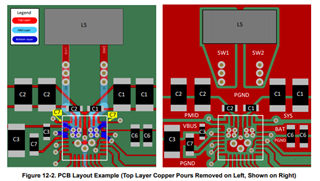Hello!
I went ahead and built this previously reviewed schematic on a custom PCB.
To test it I powered it with a current limited 18v, with No battery connected initially. No load connected either, just standalone charger circuit (Im attaching the schematic again) - no MCU, no I2C host, nothing, just the BQ chip with this schematic.
Initially the green LED D2 comes on for a few seconds, and then the input 18v source shuts down due to over current - then on the input net is permanently shorted. I also see that the PMID net is also shorted. Likely the chip is now dead. After removing the chip the short is no longer seen. The assembly is first tested for shorts, so it's something that is happening after powering the system.
This happened on two attempts on two different PCBs built for the same schematic.
Am I missing something here? Can you see anything done incorrectly that may lead to this failure?
- I have not connected the battery
- I have not connected any load
- I have a 10k on the thermistor point
- No I2C pull-ups, No I2C host
- INT_n is not connected to anywhere other than the pull-up
Any leads to trouble shoot this issue greatly appreciated please.
Thanks,Bq25792_schm_ex.pdf
Srikanth



